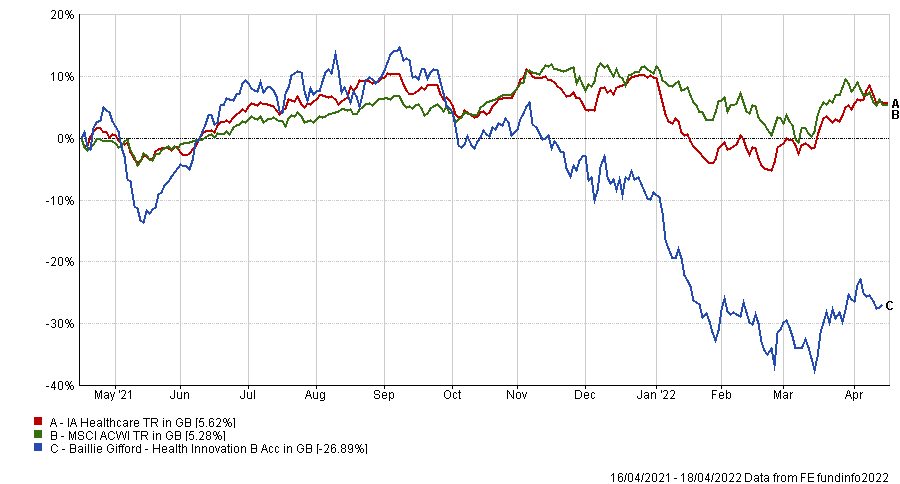Baillie Gifford is known for backing what it believes is ‘exceptional’ companies in order to achieve ‘outsized’ returns as it has demonstrated with early investments in the likes of Amazon and Tesla.
Unfortunately, this often means that the firm must endure large drawdowns in share prices when the market turns against its favourite companies.
The most recent example of this is Moderna, the US pharmaceutical and biotech company that developed messenger RNA vaccines against Covid-19. The shares are down almost 70% from its highs in late 2021.
The decline is not just limited to one company, however. Many high-growth biotech and life sciences companies have been shunned by the wider market over the past year.
Valuations for most of the industry have come down across the board as investors struggle to discount higher than expected inflation and potential interest rate hikes.
The Baillie Gifford Health Innovation fund has been hit particularly hard by the recent market volatility, down 26.9% over the past year versus a 5.3% gain from the MSCI ACWI index.
Performance of fund vs wider market over 1yr

Source: FE Analytics
The managers of the fund, however, say they still have “very strong conviction” in the long-term potential of their portfolio companies.
Rose Nguyen, co-manager of the fund, said: “It gives us good entry points and a great ability to add to positions we have conviction in.”
Although the fund has not added to its position in Moderna – it once swelled to almost 10% of the fund before dropping down to just over 5% – Nguyen revealed that there is an ongoing discussion within the team to consider doing so.
As most of the world’s population has now been vaccinated and boosted, the need for further boosters may start to dwindle as Covid-19 becomes less deadly and moves towards an endemic stage.
This, combined with higher interest rates and inflation further discounting any future potential earnings of Moderna’s vaccine programmes, has been a double whammy for its share price.
However, Nguyen said that investors cannot value Moderna based on any traditional approach of valuation.
She said: “If you want to value every single programme in the pipeline, that would be updated very quickly because the company is bringing in new programmes every day – it will be outdated very soon.
“We look at the respiratory franchise and think that franchise alone is sufficient to get us to a 2.5 times return over a five-year period.
“When you add on top other opportunities such as, rare diseases, cancer, heart diseases, and so on, the potential value can go up a lot more.”
In addition to Moderna’s respiratory vaccine programmes, it has 34 other programmes in its product pipeline – ranging from vaccines for HIV to cancer.
The team’s core investment case for the company rests on the ability of messenger RNA technology to become a new drug class that could become as big or even bigger than small molecules or antibodies.
She said: “I think ultimately, if our hypothesis becomes true, then in 10 to 20 years’ time there's a very decent chance that Moderna can become one of the biggest pharmaceutical companies in the world, which is not reflected in the current share price at all.”
Performance of Moderna over 1yr

Source: Google Finance
With a market capitalisation of $66bn, Moderna would have to roughly grow more than seven-fold in value to surpass the size of Johnson & Johnson, which is currently the biggest pharmaceutical company in the world valued at $482bn, although this relies on messenger RNA technology becoming a new class of medicine that can be applied to different diseases beyond respiratory vaccines.
Nguyen said: “So far, the progress that the company estimates is very positive. When you look at the respiratory franchise alone, Moderna has been able to show it can go after simpler viruses such as Covid and flu, but it can also combine different messenger RNA strands into one which can allow you to address the different viruses with a single shot.
“That is a new dimension of its capability that I think is being validated. That ability to combine multiple mRNA into one dose will also open the door to address much more complex viruses such as HIV and HPV – those are DNA viruses which means once they infect our body, they remain inside the cells and to tackle those more complex viruses, you need that combination technology expertise.”
In her view, Moderna has showed that it is able to continue to innovate and advance its technology.
One obstacle for the company however is that different disease areas such as cancer, liver diseases and lung diseases are more challenging to target, but Moderna is working on new delivery technologies to target specific cells such as liver cells or lung cells.
Although this technology is yet to be validated, Nguyen thinks the progress that so far is “very encouraging”.
She said Moderna’s management team is encouraged by the progress in this area, noting that “it is going to be the way that Moderna will expand in the future”.




